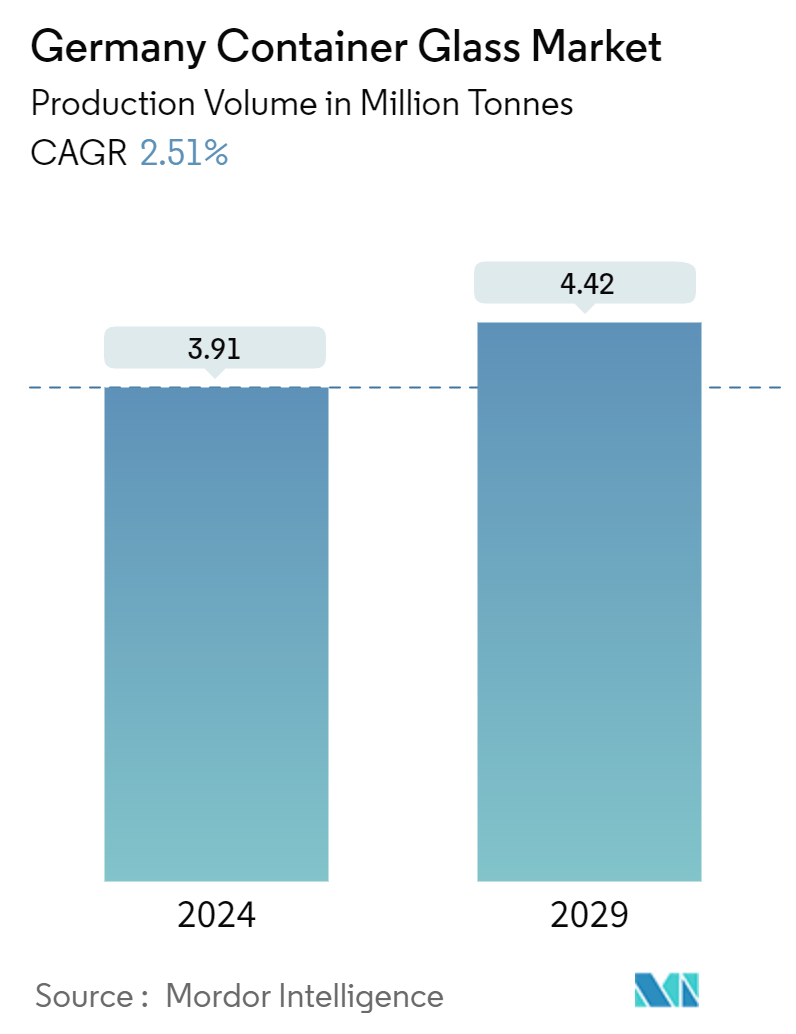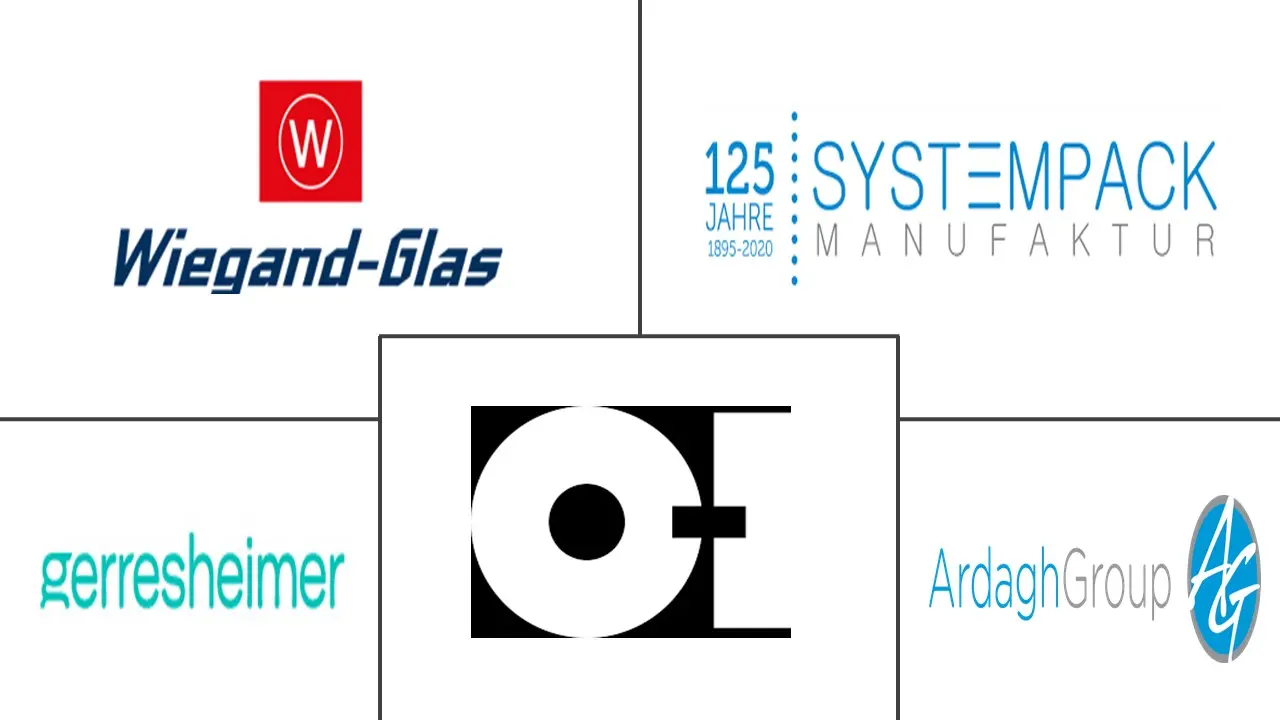Market Size of Germany Container Glass Industry

| Study Period | 2019 - 2029 |
| Base Year For Estimation | 2023 |
| Market Volume (2024) | 3.91 Million tonnes |
| Market Volume (2029) | 4.42 Million tonnes |
| CAGR (2024 - 2029) | 2.51 % |
| Market Concentration | Low |
Major Players
*Disclaimer: Major Players sorted in no particular order |
Germany Container Glass Market Analysis
The Germany Container Glass Market size in terms of production volume is expected to grow from 3.91 Million tonnes in 2024 to 4.42 Million tonnes by 2029, at a CAGR of 2.51% during the forecast period (2024-2029).
- The demand for packed food and beverage items has driven the need for container glass to store a diverse array of food ingredients. Container glass stands out as a preferred packaging material due to its attributes: sterility, reusability, chemical stability, durability, non-permeability, and malleability.
- With retail sales on the rise, manufacturers are increasingly adopting innovative packaging solutions to engage consumers. Container glass packaging, celebrated for its creative and distinctive designs, ensures products catch the eye on store shelves. This trend is accelerating the shift towards glass as a favored packaging medium.
- Data from Federal Statistics Germany (Statistisches Bundesamt) reveals that retail sales revenue climbed from EUR 577.4 billion (USD 624.89 billion) in 2020 to EUR 650.3 billion (USD 703.78 billion) in 2023. Such rising retail sales often indicate market growth, paving the way for new products and expanding the presence of existing ones.
- Germany is home to key players like Gerresheimer AG and Wiegand-Glas Holding GmbH, supplying container glass products to various sectors, including food and beverage. Wiegand-Glas Holding GmbH operates across eight locations with multiple business units. The company not only manufactures a wide array of glass products but also offers services like decoration, logistics, and recycling, boasting an annual production of over 8 million glass containers.
- Moreover, as reported by Germany Trade and Invest, Germany stands as the leading pharmaceutical market in Europe, hosting over 500 pharmaceutical companies. The demographic shift, with nearly half of the population over 45, fuels the demand for container glass in the pharmaceutical sector.
- In Germany, around 9,000 individuals are employed across 12 independent companies in the container glass sector. Many of these manufacturers are global players with production facilities not just in Germany, but also in other European countries and the USA, producing a wide spectrum of glass packaging products, as highlighted by the Federal Association of the German Glass Industry (BV Glas).
- However, the container glass market faces stiff competition from alternative packaging materials like plastic and aluminum. These alternatives, being lighter, less fragile, and sometimes more economical, attract cost-sensitive consumers. The energy-intensive nature of glass production leads to higher operational costs, making profit margins susceptible to energy price fluctuations.
Germany Container Glass Industry Segmentation
Glass Containers refer to clean bottles and jars made from glass. The scope excludes windows and other non-container glass products. Container glass is used in the alcoholic and non-alcoholic beverage industries due to its ability to maintain chemical inertness, sterility, and non-permeability. Glass packaging is valued for its unique properties, including its transparency, inertness, and ability to preserve the quality and integrity of its contents.
Germany Container Glass Market is Segmented by End-User Industry (Beverage, (Alcoholic Beverages, Non-Alcoholic Beverages), Food, Cosmetics, Pharmaceuticals, and Others). The Market Sizes and Forecasts are Provided in Terms of Volume (Tonnes) for the Above Segments.
| End-user Industry | ||||
| ||||
| Food | ||||
| Cosmetics | ||||
| Pharmaceuticals | ||||
| Other End-user Industries |
Germany Container Glass Market Size Summary
The Germany Container Glass Market is poised for steady growth, driven by the increasing demand for packaged food and beverages. The market benefits from the superior properties of soda-lime-silica-based glass, which is favored for its sterility, reusability, and chemical stability. The construction sector's expansion, fueled by population growth, further boosts the demand for this type of glass, particularly for windowpanes. The market is also supported by the high recyclability of glass containers, which helps reduce emissions and conserve raw materials. However, the manufacturing process poses environmental challenges due to the release of air pollutants, which could impact market growth. The COVID-19 pandemic has also affected supply chains, although it has increased the demand for glass packaging in the pharmaceutical sector, particularly for vaccine vials and bottles.
Germany's position as a leading pharmaceutical manufacturing hub in the European Union enhances the container glass market, with major companies like Gerresheimer AG and Schott AG expanding their operations. The alcoholic beverages sector remains a significant end-user, with glass packaging offering a premium image and extended shelf life. The market is moderately competitive, with numerous regional and global players engaging in product innovation and strategic partnerships to enhance market share. Recent acquisitions and product launches, such as those by Stoelzle Glass Group and Ardagh Group, highlight the industry's focus on sustainability and innovation. The ongoing efforts to integrate renewable energy in glass production processes further underscore the market's commitment to sustainable practices.
Germany Container Glass Market Size - Table of Contents
-
1. MARKET INSIGHTS
-
1.1 Market Overview
-
1.2 PESTEL ANALYSIS - Container Glass Industry in Germany
-
1.3 Industry Standards and Regulations for Container Glass for Packaging
-
1.4 Raw Material Analysis & Material Considerations for Packaging
-
1.5 Sustainability Trends for Packaging
-
1.6 Container Glass Furnace Capacity and Location in Germany
-
-
2. MARKET SEGMENTATION
-
2.1 End-user Industry
-
2.1.1 Beverages
-
2.1.1.1 Alcoholic Beverages
-
2.1.1.2 Non-Alcoholic Beverages
-
-
2.1.2 Food
-
2.1.3 Cosmetics
-
2.1.4 Pharmaceuticals
-
2.1.5 Other End-user Industries
-
-
Germany Container Glass Market Size FAQs
How big is the Germany Container Glass Market?
The Germany Container Glass Market size is expected to reach 3.91 million tonnes in 2024 and grow at a CAGR of 2.51% to reach 4.42 million tonnes by 2029.
What is the current Germany Container Glass Market size?
In 2024, the Germany Container Glass Market size is expected to reach 3.91 million tonnes.

